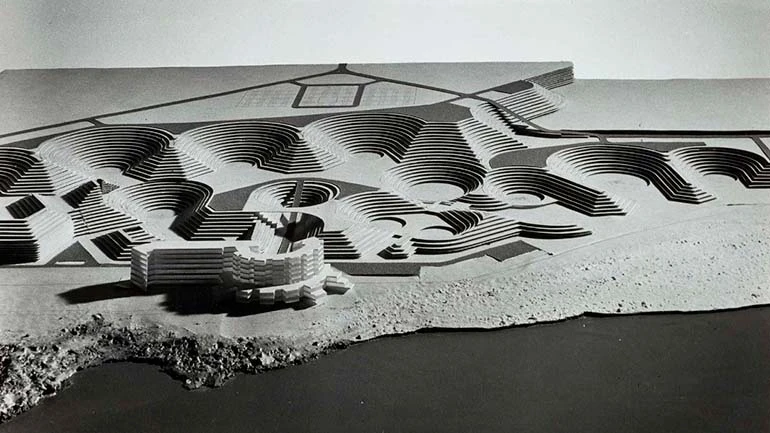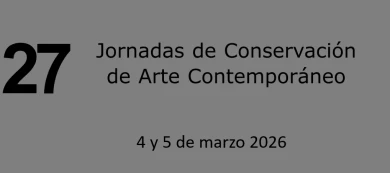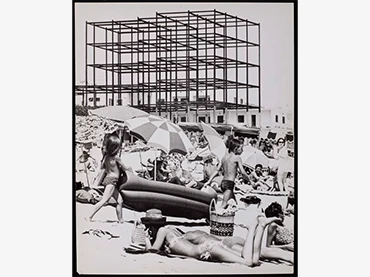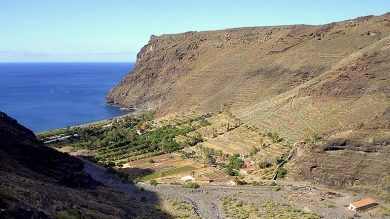
Held on 27 Jun 2022
This day of lectures and encounters, the fourth instalment of the series organised by the inter-university group TURICOM — which is part of the project Paradoxical Modernity: Artistic and Tourist Experience in Developmentalist Spain (1959–1975), PGC2018-093422-B-I00 (MCI/AEI/FEDER, UE) — endeavours to examine the relationship between tourist imaginaries and the visual arts from the 1960s onwards. By virtue of a selection of brief lectures and a final conversation, followed by a debate, it looks to reflect on mass tourism and the way in which, as the industry of experience, it is connected to the search for a lived experience that has shaped contemporary art.
In this latest edition, the idea of the tourist city as a utopia/dystopia is explored in relation to the concept of “architecture of pleasure” developed by Henri Lefebvre in his book Toward an Architecture of Enjoyment. In 1973, the French philosopher and urban planner was inspired by the work Mario Gaviria, his pupil, carried out in Benidorm. The initial title was also Gaviria’s suggestion, stemming from his view of Benidorm as a model for the future. Yet Lefebvre preferred not to speak of “pleasure” as such but jouissance, a hard-to-translate term that denotes enjoyment both beyond pleasure and also against it.
What desires did tourist cities have to arouse in their permanent or temporary residents? What were the architecture of pleasure promises and what pain did they open the way for? What dystopias have we inherited from the tourist utopias of the 1960s? These are the questions that anchor the session.
[dropdown]
Eugenia Afinoguénova is a professor of Spanish Literature and Cultural History at Marquette University in Milwaukee (USA). Her most recent publication is El Prado: la cultura y el ocio (1819-1939) (Cátedra, 2019), and she has also co-edited a number of anthologies, including Spain Is (Still) Different: Tourism and Discourse in Spanish Identity (Lexington Books, 2008, with Jaume Martí-Olivella) and the forthcoming The Edinburgh Companion to the Spanish Civil War and Visual Culture (Edinburgh University Press, 2023, with Silvina Schammah Gesser and Robert Lubar Messeri). Moreover, she has contributed to multiple anthologies focused on themes around the tourism imaginary, film and, more recently, environmental studies.
Cristina Arribas is an architect and urban planner in Badalona City Council and a professor in the Department of Theory and History at the Escola Tècnica Superior d’Arquitectura de Barcelona (ETSAB). Her most recent publications most notably include “El nuevo paisaje turístico español a través de las tarjetas postales de los años 60” in Sobre, No. 5 (2018) and “La puesta en escena del paisaje turístico español en el boom desarrollista” in La ciudad en el cine (Asimétricas, 2022).
Jordi Costa has been the head of the Exhibitions Department at the Centre de Cultura Contemporània de Barcelona (CCCB) since 2019. He is the author of books such as Todd Solondz. En los suburbios de la felicidad (Ocho y Medio, 2005) and Cómo acabar con la Contracultura. Una historia subterránea de España (Taurus, 2018). He has also co-curated exhibitions such as Plagiarism (La Casa Encendida, 2005–2006) and The Mask Never Lies (CCCB, 2021–2022).
José Díaz Cuyás is a professor of Aesthetics and Art Theory at the University of La Laguna. With Carmen Pardo and Esteban Pujals, he curated The Pamplona Encounters 1972: The End of the Party for Experimental Art (Museo Reina Sofía, 2009–2010). His most recent publications notably include his coordination of issue 10 (on art and tourism) of Concreta magazine, and “Movilizados por lo real: turistas, soldados, artistas” (on Marcel Broodthaers), in Arquitectura: lenguajes fílmicos (2009-2016) (Tabakalera, 2018).
Ramón Vicente Díaz del Campo Martín-Mantero is an art historian and professor of Contemporary Spanish Art and Exhibition Curatorship at the University of Castilla-La Mancha. His main works revolve around architect Miguel Fisac, the subject of his PhD thesis. Notable among his publications are articles and texts that address different aspects of Spanish art during the 1950s and 1960s.
Julián Díaz Sánchez is a professor of Art History at the University of Castilla-La Mancha (UCLM). He has written, among other works, Políticas, poéticas y prácticas artísticas. Apuntes para una historia del arte (Catarata, 2009), La idea de arte abstracto en la España de Franco (Cátedra, 2013) and Pensar la historia del arte. Viejas y nuevas propuestas (Universidad de Zaragoza, 2021).
Germán Labrador Méndez is director of the Museo Reina Sofía’s Public Activities Department.
Antoni Miralda is a visual artist whose work is aligned towards investigations into food-related rituals, practices and symbolism. To this end, he has worked with collaborators such as Montse Guillén and Dorothée Selz to develop projects like Honeymoon Project (different locations, 1986–1992). Since 2000, he has focused his work on the FoodCulturaMuseum, an archive related to gastronomic diversity and its ties with world cultures and which, based out of Miami and Barcelona, explores and disseminates food culture in a multidisciplinary way. In 2010, the Museo Reina Sofía welcomed his solo show Miralda. De gustibus non disputandum.
[/dropdown]
5pm
Panel of lectures
—Presentation by José Díaz Cuyás
The Urbanism of Leisure Towards 1970
Eugenia Afinoguénova
“It is in the architecture and urbanism of leisure […] where, in a simplified manner, the full contradictions materialise that appear in consumer societies of bureaucratically led masses”, Mario Gaviria wrote in “The Urbanism of Leisure” in City and Territory No. 2 (1969). Surveying illustrated magazines from the early 1970s, this lecture gives context to the promises and failures of tourist cities in debates on the future of work, automation, mobility and social inequality after May ’68.
Images of the Tourist City
Julián Díaz Sánchez
The resurgence in 1970s Spanish painting of the Mediterranean aesthetic (at least as a topic of conversation) entails a (utopian?) vision of the tourist city. The notion of tourism slides around realist painting (or “committed”, as it was called at the time) and that which stresses the pleasure and warmth of the picture, with both revealing the notion of urban utopia.
“Utopia for Today, Dystopia for Tomorrow”. Remote Postcards
Cristina Arribas
With Americanisation as a “utopia” the starting point, Spain programmed its mass modernisation through tourist culture. Economic development approaches irremediably transformed the landscape (ideal, in theory) to turn it into a stage of literally consumed mass consumption. Postcards — also objects of tourism and consumerism — are good examples of this new world in colour and they multiplied in the developmentalist “ideal”, the seed of their destruction. Utopia or development? Postcards don’t lie, or do they?
Unique Proposals in the Landscape of Spanish Tourism. Fernando Higueras in Lanzarote
Ramón Vicente Díaz del Campo Martín-Mantero
In response to the standard tourism architecture built on most Spanish coastlines during the developmentalism period, certain unique approaches sprouted, for instance the works designed by Fernando Higueras in Lanzarote. Although only some were built, all were designed in the search to integrate architecture and nature to make the island a more prosperous place through the economic driving force of tourism, but without losing the most salient aspect of its identity: the landscape. This lecture analyses the architect’s different proposals, centring on Ciudad de las Gaviotas (The City of Seagulls, 1970) located on Risco de Famara.
6pm - 6:45pm
Conversation. Colourist Utopias (Or Dystopias?) from Consumer Society. Greetings from Counterculture
Antoni Miralda and Jordi Costa
The holiday resort as a dystopian territory, variables of the concept of post-tourism and the productive paradoxes that can make an ostensibly trivial object a souvenir are some of the concepts around which this lecture pivots. A selection of noteworthy works by Antoni Miralda, able to activate some of the contradictions inherent in this ritual of the tourist experience — which, post-pandemic, appears to have survived its foretold apocalypse — will colour the different seasons of this journey.
7pm
Conclusions and Final Debate
—Moderated by Germán Labrador Méndez
Organised by
Museo Reina Sofía and the inter-university research group TURICOM. The Tourist Experience: Image, Body and Death in the Culture of Leisure
Inside the framewrk of
TIZ 4. Slumil K’ajxemk’op (Rebel Land)
Participants
Participants
Más actividades

Difficulty. Forms and Political Effects of Deviation in Writing and Contemporary Art
23 February – 14 December 2026 – Check programme
Difficulty. Forms and Political Effects of Deviation in Writing and Contemporary Art is a study group aligned towards thinking about how certain contemporary artistic and cultural practices resist the referentiality that dominates the logics of production and the consumption of present-day art. At the centre of this proposal are the concepts of difficulty and deviation, under which it brings together any procedure capable of preventing artistic forms from being absorbed by a meaning that appears previous to and independent from its expression. By ensuring the perceptibility of their languages, difficulty invites us to think of meaning as the effect of a signifying tension; that is, as a productive and creative activity which, from the materiality of art objects, frees aesthetic experience from the representational mandate and those who participate in it from the passiveness associated with tasks of mimesis and decoding.
The economy of the referential norm translates the social logic of capitalism, where insidious forms of capturing subjectivity and meaning operate. In the early 1980s, and adopting a Marxist framework, poet Ron Silliman highlighted how this logic entailed separating language from any mark, gesture, script, form or syntax that might link it to the conditions of its production, rendering it fetichised (as if without a subject) and alienating its users in a use for which they are not responsible. This double dispossession encodes the political strategy of referential objectivity: with no subject and no trace of its own consistency, language is merely an object, that reality in which it disappears.
The political uses of referentiality, more sophisticated today than ever before, sustain the neoliberal-extractivist phase of capitalism that crosses through present-day societies politically, economically and aesthetically. Against them, fugitive artistic practices emerge which, drawing from Black and Queer studies and other subaltern critical positions, reject the objective limits of what exists, invent forms to name what lies outside what has already been named, and return to subjects the capacity to participate in processes of emission and interpretation.
Read from the standpoint of artistic work, the objective capture of referentiality may be called transparency. Viewed from a social contract that reproduces inequality in fixed identity positions, transparent in this objectivity are, precisely, the discourses that maintain the status quo of domination. Opposite the inferno of these discourses, this group aims to collectively explore, through deviant or fugitive works, the paradise of language that Monique Wittig encountered in the estranged practices of literature. For the political potency of difficulty — that is, its contribution to the utopia of a free language among equals — depends on making visible, first, its own deviations; from there, the norm that those deviations transgress; and finally, the narrowness of a norm which in no way exhausts the possibilities ofsaying, signifying, referring and producing a world.
From this denouncement of referential alienation, fetishisation and capture, Difficulty. Forms and Political Effects of Deviation in Writing and Contemporary Art turns its attention to the strategies of resistance deployed by contemporary artists and poets. Its interest is directed towards proposals as evidently difficult or evasive as those of Gertrude Stein, Lyn Hejinian, Theresa Hak Kyung Cha, Kameelah Janan Rasheed, Kathy Acker, María Salgado and Ricardo Carreira, and as seemingly simple as those of Fernanda Laguna, Felix Gonzalez Torres and Cecilia Vicuña, among other examples that can be added according to the desires and dynamics of the group.
The ten study group sessions, held between February and December, combine theoretical seminars, work with artworks from the Museo Reina Sofía’s Collections and exhibitions, reading workshops and public programs. All these formats serve as spaces of encounter to think commonly about certain problems of poetics — that is, certain political questions — of contemporary writing and art.
Difficulty. Forms and Political Effects of Deviation in Writing and Contemporary Art inaugurates the research line Goodbye, Representation, through which the Museo Reina Sofía’s Studies Directorship seeks to explore the emergence of contemporary artistic and cultural practices which move away from representation as a dominant aesthetic-political strategy and redirect their attention toward artistic languages that question the tendency to point, name and fix, advocating instead for fugitive aesthetics. Over its three-year duration, this research line materializes in study groups, seminars, screenings and other forms of public programming.

CLINIC 2628. A Community of Writing and Research in the Arts
February – October 2026
Clinic 2628 is a project which supports and brings together writings which stem from the intention to offer a space and sustainable time for research work in art and culture. Framed within an academic context which is increasingly less receptive to the forms in which thinking happens and is expressed, the aim is to rescue the academic from its neoliberal trappings and thus recover the alliance between precision and intuition, work and desire. A further goal is to return writing to a commons which makes this possible through the monitoring of processes and the collectivisation of ideas, stances, references and strategies.
The endeavour, rooted in a collaboration between the Museo Reina Sofía’s Studies Directorship and the Artea research group, via the i+D Experimenta project, is shaped by three annual editions conceived as spaces of experimentation, discussion and a demonstration of writings critical of what is put forward by today’s academia.
What forces, forms and processes are at play when writing about art and aesthetics? In academia, in museums and in other cultural institutions, the practice of writing is traversed by productivist logics which jeopardise rhythms of research and experimentation. The imposition of both scientism inherent in the structure of “the paper” and the quantifying of results which demand a criterion of quality and visibility sterilise and smoothen, from the outset, the coarseness that is particular to writing understood from the concrete part of language: phonic, graphic, syntactic and grammatical resistance connecting the language user to the community the language unites and activates. They also sterilise the roughness enmeshed in the same desire to write, the intuitive, clear and confusing pathways that once again connect the writer to those reading and writing, participating in a common good that is at once discovered and produced.
The progressive commercialisation of knowledge propelled by cognitive capitalism moves further away from the research and production of knowledge in artworks and artistic languages and practices. The work of curators and archive, criticism, performances and essays formerly saw a horizon of formal and emotional possibilities, of imagination that was much broader when not developed in circumstances of competition, indexing and impact. Today, would it be possible to regain, critically not nostalgically, these ways; namely, recovering by forms, and by written forms, the proximity between art thinking and its objects? How to write in another way, to another rhythm, with no more demands than those with which an artwork moves towards different ways of seeing, reading and being in the world?

27th Contemporary Art Conservation Conference
Wednesday, 4, and Thursday, 5 March 2026
The 27th Contemporary Art Conservation Conference, organised by the Museo Reina Sofía’s Department of Conservation and Restoration, with the sponsorship of the MAPFRE Foundation, is held on 4 and 5 March 2026. This international encounter sets out to share and debate experience and research, open new channels of study and reflect on conservation and the professional practice of restorers.
This edition will be held with in-person and online attendance formats, occurring simultaneously, via twenty-minute interventions followed by a five-minute Q&A.
Submitting Proposals
The deadline for presenting proposals ends on 28 September 2025. Those interested must send an email to jornada.conservacion@museoreinasofia.es, submitting the following documents:
- An unpublished proposal related to the conservation or restoration of contemporary art.
- A 1,700-word summary, written in Word, on the theme addressed. Please indicate the topic at the top of the document with five keywords and the presentation format (in-person or virtual). Preference will be given to the in-person format.
- CV and contact details.
- Only one proposal per person will be accepted.
- Proposals related to talks given in the last three conferences will not be accepted.
Proposals may be submitted in Spanish, French or English and will be evaluated by a Scientific Committee, which will select the submissions to be presented during these conference days and will determine their possible participation in a subsequent publication, the inclusion of which will undergo a second and definitive evaluation by the Editorial Committee.
For submissions in a virtual format, participants must send a recording following certain technical requirements they will receive once participation is confirmed.
The programme of sessions will be published in the coming days.

Cultural Work
Thursday, 12 February 2026 – 5:30pm
This series is organised by equipoMotor, a group of teenagers, young people and older people who have participated in the Museo Reina Sofía’s previous community education projects, and is structured around four themed blocks that pivot on the monstrous.
Session number two looks to approach film as a place from which cultural work is made visible and processes of production engage in dialogue with artistic creation. From this premise, the session focuses on exploring how audiovisual content is produced, assembled and distributed, from the hands that handle the images to the bodies that participate in its circulation. The aim is to reflect on the invisible effort, precarity and forms of collaboration that uphold cultural life, that transform the filmic experience into an act that recognises and cares for common work.

The (legal) person and the legal form. Chapter II
8, 12, 15 January, 2026 – 16:00 to 19:00
As part of the Studies Constellation, the Study Directoship’s annual fellowship, art historian and theorist Sven Lütticken leads the seminar The (Legal) Person and the Legal Form: Theoretical, Artistic, and Activist Commitments to foster dialogue and deepen the hypotheses and questions driving his research project.
This project, titled Unacting Personhood, Deforming Legal Abstraction, explores the dominance of real abstractions—such as exchange value and legal form—over our processes of subjectivation, and asks how artistic practices can open up alternative ways of representing or performing the subject and their legal condition in the contemporary world.
The seminar consists of eight sessions, divided into three chapters throughout the academic year. While conceived as non-public spaces for discussion and collective work, these sessions complement, nourish, and amplify the public program of the Studies Constellation.
In this second chapter of the seminar, the inquiry into the aesthetics and politics of legal form continues with three sessions that pick up the discussions held in Chapter I but propose new lines of flight. The first session focuses on international law via the writings of the British author China Miéville, which allows us to reconsider the notion of the legal form –following Evgeny Pashukanis— and, through it, a variety of (people’s) tribunals. While the crucial concept of the legal person –as the right-holder central to the form of law— was debated in Chapter I, the second session focuses on attempts to extend personhood not (just) to corporations, but rather to nonhuman animals or ecosystems. Finally, the third session poses the question: how can groups and networks use officially recognized organizational forms (such as the foundation or the cooperative) and/or use a collective persona (without necessarily a legal “infrastructure” to match) to act and represent themselves?

![Joan Rabascall. Every Day a Fiesta [Cada día una fiesta], 1975](https://recursos.museoreinasofia.es/styles/small_landscape/public/Actividades/espana-g.gif.webp)




![Miguel Brieva, ilustración de la novela infantil Manuela y los Cakirukos (Reservoir Books, 2022) [izquierda] y Cibeles no conduzcas, 2023 [derecha]. Cortesía del artista](https://recursos.museoreinasofia.es/styles/small_landscape/public/Actividades/ecologias_del_deseo_utopico.jpg.webp)
![Ángel Alonso, Charbon [Carbón], 1964. Museo Reina Sofía](https://recursos.museoreinasofia.es/styles/small_landscape/public/Actividades/perspectivas_ecoambientales.jpg.webp)